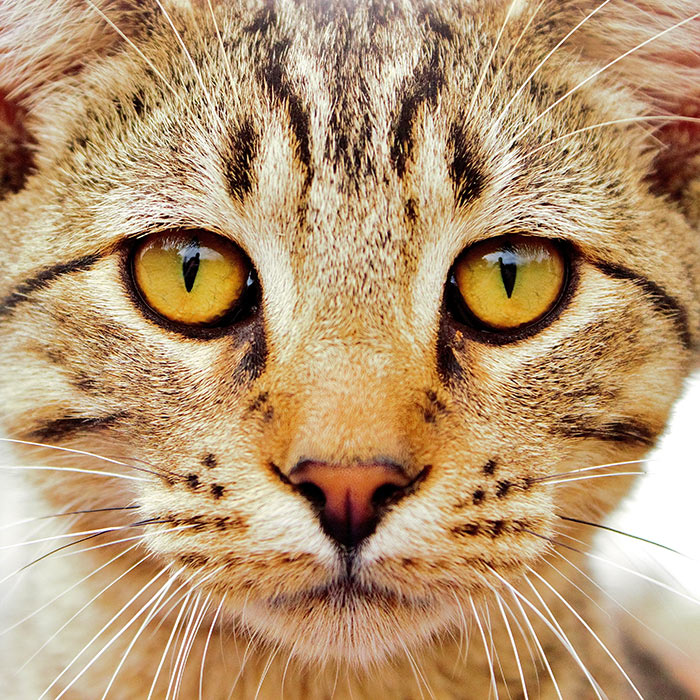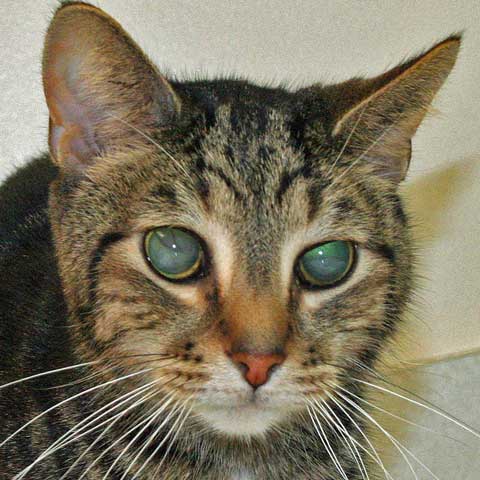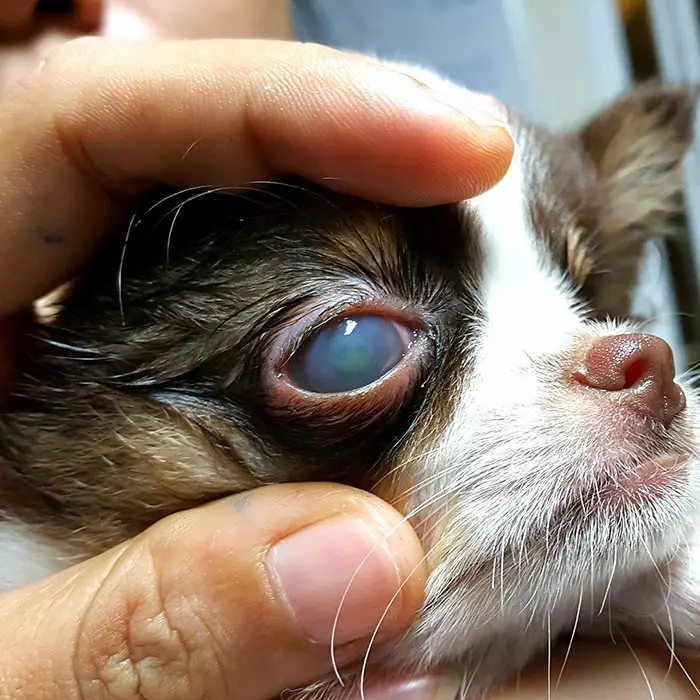Uveitis in dogs and cats
What is uveitis?
In order to understand what uveitis is, it is necessary to understand the composition of a dog’s eye. The eye is made up of three primary layers: the outer layer, which includes the cornea (the clear outer surface) and the sclera (the white), the inner layer, comprising the light-sensitive retina, and the middle layer, called the uvea or uveal tract.
The uvea is made up of three structures:
- Iris – The pigmented part of the eye that gives the eye its distinctive colour.
- Choroid layer – The layer of blood vessels and connective tissue between the sclera and the retina
- Ciliary body – A thickened extension of the choroid that connects the choroid and the iris. It secretes the transparent fluid (aqueous humor) into the eye, which provides important nutrients and maintains intra-ocular pressure (IOP). The ciliary body contains the suspensory ligament and ciliary muscles which support the lens and control its shape and hence its ability to focus images.
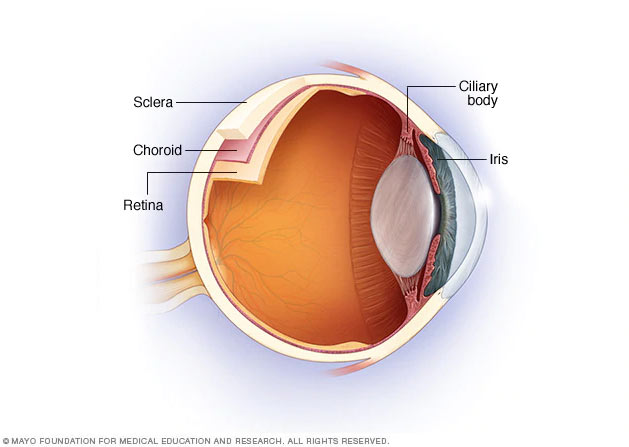
Source: https://www.mayoclinic.org/-/media/kcms/gbs/patient-consumer/images/2013/11/15/17/35/ds00677_-ds01128_im04355_ans7_uveitis2thu_jpg.jpg
Uveitis is an ocular (eye) disease in which there is inflammation of one or more of the uveal structures.
The uvea is highly vascularised; it contains many blood vessels. When uveitis occurs, these structures become progressively inflamed, causing damage to the tissues and severe ocular pain. Uveitis can be a serious condition, even leading to permanent blindness.
Since the uvea includes the iris, the ciliary body and the choroid, the term uveitis encompasses iritis, cyclitis and choroiditis. Clinically, the iris and ciliary body usually react together, while the choroid behaves somewhat independently. Anterior uveitis, which means “inflammation of the front of the eye”, refers to inflammation of the iris and ciliary body, and is one of the most common ocular diseases in dogs and cats. Choroiditis, or posterior uveitis, is far less frequently diagnosed in veterinary medicine.
Uveitis may occur unilaterally (in one eye) or bilaterally (in both eyes) and it may be acute (sudden onset) or chronic (slow and progressive). Systemic causes of uveitis tend to occur in both eyes, whereas ocular disorders are more likely to affect just one eye.
Symptoms of uveitis in dogs and cats
The symptoms of uveitis often come on suddenly and worsen quickly. The most common symptom is a colour change to the eye, which may appear cloudy and/or red. This is an extremely painful condition and the animal may squint and paw at the affected eye. Other symptoms may include:
- Swelling of eyeball or eye area
- Severe pain
- Intense redness
- Cloudy appearance to the eye
- Change in appearance of iris
- Unusual colour of the iris
- Unusually small (constricted) pupil
- Abnormally shaped pupil
- Constant, excessive tearing
- Excessive blinking
- Decreased vision
- Keeping the eye shut
- Avoidance of bright light, photophobia (light sensitivity)
- Squinting
- Bleeding into the eye
- Pawing at eye
- Watery discharge
- Mucus or pus discharge
- Third eyelid elevation
- Rubbing of the eye
- Vision problems
- Cataracts
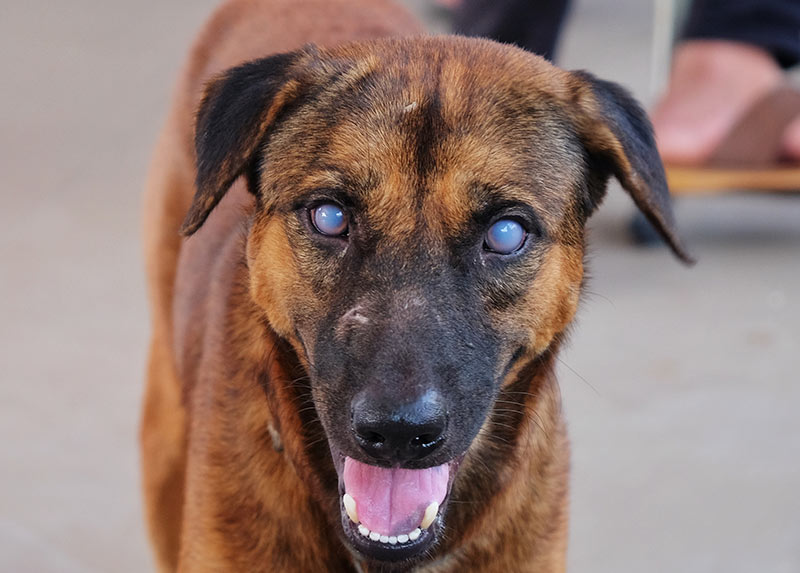
Causes of uveitis in dogs and cats
There are many possible causes of uveitis, including trauma, infection (bacterial, viral or fungal) and cancer. It is important to identify the underlying cause in order to provide proper treatment and ensure the animal recovers. However, in approximately 60 to 75 percent of cases, the cause cannot be identified (this is termed ‘idiopathic uveitis’), even with extensive diagnostic tests.
Some of the most common identified causes include:
Eye trauma or injury:
- Corneal ulceration
- Blunt trauma
- Penetrating trauma
- Lens damage resulting in the leakage of lens protein into the eye fluid
- Hyper-mature cataract
- Lens luxation (dislocation)
Cancer:
- Iris melanoma
- Trauma-associated sarcoma
- Lymphoma
- Metastatic tumour
- Localised tumour
Systemic disorders:
- Autoimmune diseases
- Immune-mediated thrombocytopenia
- Immune-mediated vasculitis
- Immune-mediated haemolytic anaemia
- Metabolic disease
- Diabetes mellitus
- High blood pressure
Fungal infections:
- Blastomycosis
- Cryptococcosis
- Histoplasmosis
- Coccidiodomycosis
- Candidiasis
Bacterial infections:
- Bartonella henselae (a proteobacterium that is the causative agent of cat-scratch disease)
- Mycobacterium
Parasites:
- Toxoplasmosis (a multi-system disease caused by a parasite called Toxoplasma gondii)
- Rickettsia (a parasitic disease found in many ticks, fleas and lice)
Viruses – the viral agents are different for each species
Common viral causes in dogs include:
- The canine herpes virus
- Canine distemper virus
- Canine adenovirus type 1
Common viral causes in cats are:
- Feline infectious peritonitis (FIP)
- Feline immunodeficiency virus (FIV)
- Feline herpesvirus-1 (FHV-1)
- Feline leukaemia virus (FeLV)
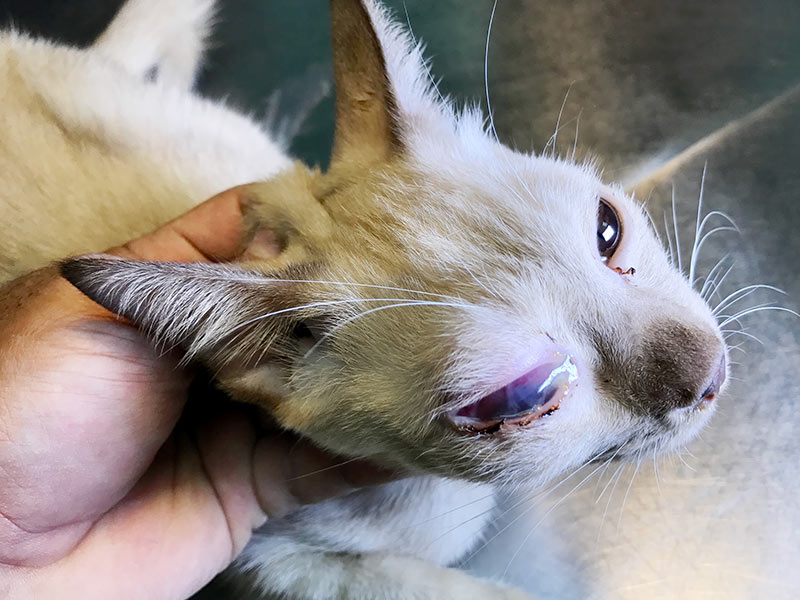
How is uveitis in dogs and cats diagnosed?
Uveitis can present in a similar manner to several other ocular conditions. The veterinarian will examine the dog or cat’s eye to eliminate other possible causes of the symptoms, such as glaucoma and corneal ulcers. It is important to establish a prompt, accurate diagnosis in order to give the appropriate prognosis and treatment. In addition to magnification of the uveal tract, special diagnostic procedures such as ultrasound may be used to examine the eye.
Additional work-up and diagnostic testing may be necessary to find the underlying cause of uveitis, if possible.
Physical examination
Since uveitis may be a sign of an underlying systemic disease (one affecting the entire body), a complete history and thorough physical examination will be performed. The veterinarian will examine the animal’s body to observe any signs of illness, as well as the eyes to look for possible trauma. He or she will obtain a complete medical history including any other symptoms the owner may have noticed or any recent illness.
Ophthalmoscopic examination
The veterinarian will closely examine the eye using an ophthalmoscope, a small handheld instrument to examine the inside of the eye. Using this tool, he or she should be able to determine that the issue concerns the uvea.
Tonometry
This is a quick and painless test to measure the pressure inside the eyes. If a tonometer is available, it will be utilised because uveitis is typically associated with low intraocular pressure (IOP). Tonometry can also be very indicative of glaucoma, a group of eye diseases that destroy the optic nerve at the back of the eye. Many of the signs of uveitis are similar to glaucoma; however, with uveitis, IOP is reduced (low) whereas with glaucoma it is elevated (high).
Slit lamp
The veterinarian may use a handheld slit lamp, a microscope with a bright light that shines into the eye, to closely examine the interior of the eye in order to identify intraocular inflammation or other signs of uveitis.
Additional ocular (eye) tests
- Ocular ultrasound – if the vet believes the animal has suffered eye trauma or injury, an ultrasound of the eye may be performed to look at the extent of the damage.
- X-rays of the eye
- An aspirate from the eye for microscopic examination and culture
- Fluorescein staining to evaluate for corneal ulcers
Systemic tests
A complete blood count, urinalysis, and biochemical profile will be performed to get a better picture of the animal’s overall health, because uveitis can be the first or only sign of a systemic and possibly life-threatening disease. Specific laboratory tests can help the vet determine if the animal is suffering from any autoimmune diseases, infectious organisms, or other underlying diseases.
If there is suspicion of a systemic disease, the vet will perform further tests, which may include:
- Specific tests for infection and systemic diseases (FeLV, FIV, toxoplasmosis etc.)
- Blood pressure test to check for hypertension
- Thoracic X-rays to check for fungal diseases or tumours
- Abdominal ultrasound to look for fluid in the abdomen (if FIP is suspected)
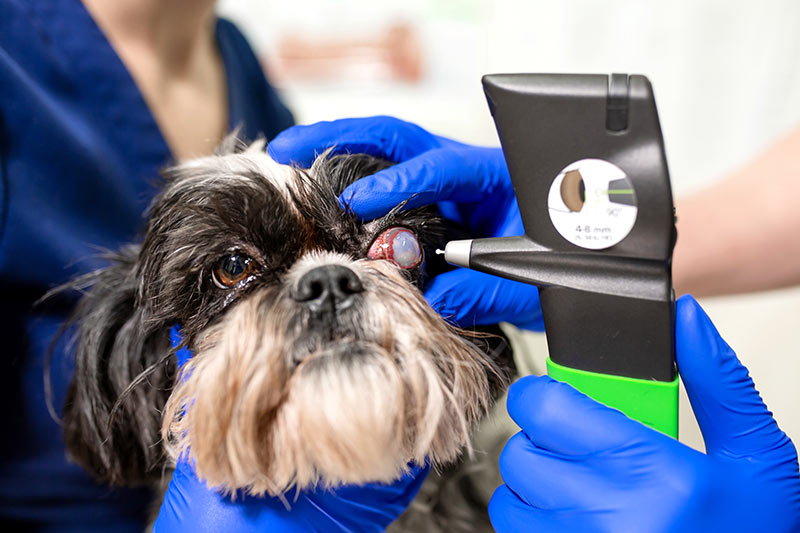
Prognosis
The prognosis for uveitis depends on the promptness of diagnosis and treatment. In most cases, inflammation and pain will substantially improve within 24 hours of treatment. Once the condition resolves, follow-up veterinary visits will be necessary to determine the effectiveness of initial treatment, and if the condition has caused damage to any of the structures of the eye.
If left untreated for an extended period, or if the eye is very cloudy or if haemorrhage has occurred, it may take longer to see progress. Left untreated altogether, uveitis may damage the lens of the eye, which could lead to cataracts (cloudiness of the lens), lens subluxation (dislocation of the lens), retinal detachment, phthisis (shrinkage and atrophy of the eyeball) and blindness.
Typically, there is a straight-forward, quick recovery from the first case of uveitis. Unfortunately, uveitis usually returns after it has been treated and often becomes a lifetime disease, requiring ongoing treatment and care. Complications are more common after very severe or recurrent cases of uveitis. These can involve the development of synechiae (adhesions between the lens and the iris) and glaucoma. Both complications may need specialist treatment. Severe uveitis can result in partial or substantial vision loss or even irreversible blindness.
Treatment for uveitis in dogs and cats
The initial treatment is aimed at reducing inflammation and providing pain relief. If the cause of the uveitis is identified (i.e. the diagnosis is not idiopathic uveitis), an appropriate course of treatment to target the underlying cause will begin. As a rule, it is generally better to over-treat uveitis since the consequences of ocular inflammation can be devastating to the eye in a very short period of time.
Treatment for pain and inflammation
Treatment for uveitis during the initial veterinary visit will focus on decreasing inflammation and pain in the eye. Medications may be needed in the short term or may be life-long, and may include:
- Glucocorticoids (or corticosteroids), a class of steroid hormones, applied topically, is the primary treatment of ocular inflammation
- Mydriatics, medication to keep the pupils dilated in order to prevent the inflamed iris from sticking to the pupil
- Nonsteroidal anti-inflammatory drugs (NSAID) in the form of eye drops, ointments and/or oral medication
- The injection of medication directly into the eye to reduce the pressure
- Analgesics for pain relief
- Topical anti-biotics to prevent secondary bacterial infection
Treatment of the underlying cause
If identified, the underlying cause of the condition will determine the next phase of the treatment protocol:
- Infection – antibiotic, anti-parasitic, anti-fungal or antiviral medication, depending on the type of infection.
- Immune-related disorders – steroids administered orally to help suppress the over-active immune system.
- Diabetes – dietary modification to help manage the condition. If the diabetes is unmanageable, insulin injections on a regular basis.
- Trauma – surgery to repair any damage such as corneal tears or to remove a foreign body from the eye. This may involve referral to a specialist.
- Cancer – treatment may entail:
- surgery to remove the cancerous tissue within the eye
- eye removal (enucleation) where there are tumours of the eye
- surgery and/or chemotherapy for cats with other forms of cancer
In order to assess the initial response to treatment, your veterinarian will need to examine your dog frequently. Follow-up care will be necessary to monitor progress. Unfortunately, uveitis is a disease which frequently recurs and may require lifelong treatment.
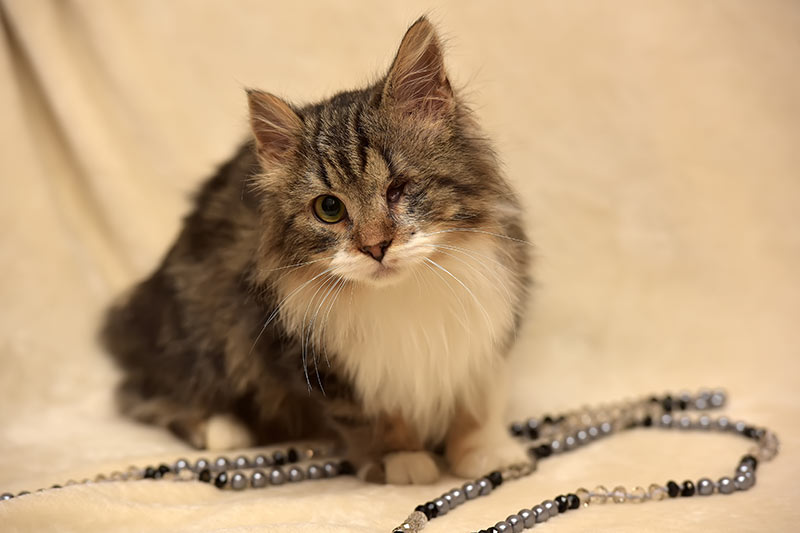
In summary
The uvea is the middle layer of tissue in the eye, consisting of the iris, choroid and ciliary body. Uveitis is inflammation of the uvea, an ocular disease frequently encountered in dogs and cats. It can induce severe ocular pain and visible symptoms such as eye discharge, excessive blinking and extreme redness.
Many different conditions can result in uveitis, including infections, trauma, cancer, autoimmune disorders and diabetes. However, in the majority of cases, uveitis is idiopathic, meaning its cause is unknown. Recurrent episodes, complications and permanent vision loss can occur. Treatment will focus on relieving pain, making the animal more comfortable and treating the underlying cause where possible.
Bow Wow Meow Pet Insurance can help protect you and your pet should an unexpected trip to your vet occur.
- Find out more about our dog insurance options
- Find out more about our cat insurance options
- Get an instant online pet insurance quote


More information
- https://wagwalking.com/condition/uveitis
- https://wagwalking.com/cat/condition/anterior-uveitis
- https://vcahospitals.com/know-your-pet/uveitis-in-dogs
- https://vcahospitals.com/know-your-pet/uveitis-in-cats
- https://www.petmd.com/dog/conditions/eyes/c_dg_anterior_uveitis
- https://www.petmd.com/cat/conditions/eyes/c_ct_anterior_uveitis
- https://www.ncbi.nlm.nih.gov/pmc/articles/PMC1790624/
- https://www.ncbi.nlm.nih.gov/pubmed/15948426
- http://www.pethealthnetwork.com/cat-health/cat-diseases-conditions-a-z/uveitis-cats
- http://animaleyecare.net/diseases/uveitis/
- https://www.cat-world.com.au/uveitis-in-cats.html








